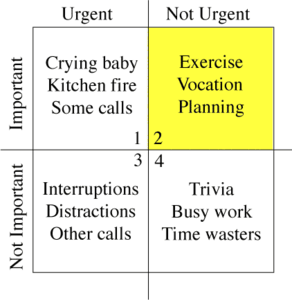Mastering Priorities: Balance Work & Life with Eisenhower Matrix

Introduction
The Eisenhower Matrix, an exceptional tool for prioritizing tasks, can revolutionize the lives of remote workers, freelancers, digital nomads, and entrepreneurs. Named after President Dwight D. Eisenhower, this matrix is a guiding light for those who value flexibility, independence, growth, and financial freedom. This article will explore how the Eisenhower Matrix can empower remote work success by improving time management and productivity, enabling a healthy work-life balance.
Understanding the Eisenhower Matrix
The Eisenhower Matrix is a simple yet effective method for organizing tasks based on their urgency and importance. It consists of a 2x2 grid, with each quadrant representing a different level of priority:
- Urgent and important tasks: These tasks require immediate attention and have significant consequences if not completed. They should be tackled first.
- Important but not urgent tasks: These tasks are essential for long-term success but do not demand immediate action. Schedule time for these tasks after addressing urgent matters.
- Urgent but not important tasks: These tasks require prompt attention but have minimal impact on your overall goals. Delegate or automate these tasks whenever possible.
- Neither urgent nor important tasks: These tasks offer little value and consume valuable time. Eliminate or minimize these tasks, making room for more important activities.

Applying the Eisenhower Matrix to Remote Work

Remote workers, freelancers, and digital nomads often face unique challenges when it comes to managing their time effectively. The Eisenhower Matrix can be instrumental in overcoming these obstacles, allowing you to prioritize tasks and maintain a healthy work-life balance. Here’s how you can put the matrix to work for you:
List and categorize your tasks
Begin by creating a comprehensive list of your tasks, including work-related duties, personal goals, and routine responsibilities. Once you have compiled your list, categorize each task according to the Eisenhower Matrix’s four quadrants. Be honest with yourself about which tasks truly demand your attention and which can be delegated or eliminated.
Address urgent and important tasks immediately
Tackle urgent and important tasks without delay. These tasks often involve impending deadlines, critical issues, or significant consequences if left unaddressed. By dealing with these tasks promptly, you can minimize stress and ensure that your most pressing responsibilities are under control.
Schedule time for important but not urgent tasks
While it’s tempting to focus on urgent matters, setting aside time for important but not urgent tasks is crucial. These tasks contribute to your long-term success and should not be neglected. Allocate dedicated time in your schedule for these activities and resist the urge to procrastinate or become sidetracked by less important matters.
Delegate or automate urgent but not important tasks
Outsourcing or automating urgent but not important tasks can free up time and mental energy, allowing you to focus on your most critical responsibilities. Identify tasks that can be delegated to a virtual assistant or automated using software and technology. By doing so, you can ensure that these tasks are handled efficiently while maximizing your productivity.
Eliminate or minimize neither urgent nor important tasks
Tasks that fall into the fourth quadrant of the Eisenhower Matrix offer little value and should be eliminated or minimized. By cutting out these activities, you can free up time for more meaningful pursuits, whether it’s focusing on your career, personal development, or leisure.
Maintaining Work-Life Balance with the Eisenhower Matrix
The Eisenhower Matrix helps improve productivity and promotes a healthier work-life balance. By prioritizing tasks effectively, you can ensure that both your professional and personal lives receive the attention they deserve. Consider the following tips for maintaining a balanced lifestyle:
- Set boundaries: Establish clear boundaries between work and personal time. This may involve designating specific hours for work and leisure, creating a dedicated workspace, or setting rules for when and how you engage with work-related matters outside of your designated work hours.
- Practice self-care: Prioritize activities that contribute to your mental, emotional, and physical well-being. Make time for exercise, hobbies, relaxation, and socializing with friends and family. By taking care of yourself, you’ll be better equipped to handle the demands of your professional life.
- Regularly reevaluate your priorities: As your circumstances and goals evolve, your priorities may shift. Regularly review your task list and Eisenhower Matrix to ensure that you are allocating your time and energy to the most important and relevant tasks.
- Learn to say “no”: Recognize that your time is valuable and limited. Be selective about your tasks and commitments, and don’t be afraid to say “no” to activities that don’t align with your priorities.
Overcoming Challenges with the Eisenhower Matrix
While the Eisenhower Matrix is a valuable tool for managing your time and tasks, you may encounter some challenges when putting it into practice. Here are a few tips to help you overcome these obstacles:
Trust your intuition
At times, it might be difficult to determine which quadrant a task belongs to, especially if you’re unfamiliar with the Eisenhower Matrix. Trust your intuition, and don’t be afraid to make adjustments as you gain experience with the matrix. The more you use it, the better you’ll become at accurately prioritizing your tasks.
Break down complex tasks
Large or complex tasks can be daunting and may not fit neatly into a single quadrant. Break these tasks down into smaller, more manageable components, and assign each component to the appropriate quadrant. This approach will help you tackle complex projects more efficiently and effectively.
Review and adjust regularly
Your priorities and responsibilities may change over time. Regularly review your task list and Eisenhower Matrix to ensure that they accurately reflect your current goals and priorities. Be prepared to make adjustments as needed and maintain a flexible mindset when dealing with unforeseen challenges.
Don’t strive for perfection
It’s essential to remember that no productivity system is perfect, and the Eisenhower Matrix is no exception. Rather than striving for perfection, focus on making incremental improvements to your time management and prioritization skills. Over time, these small improvements will add up to significant gains in productivity and work-life balance.
Final Thoughts
The Eisenhower Matrix is a powerful tool for enhancing productivity and achieving a healthy work-life balance, particularly for remote workers, freelancers, and digital nomads. By effectively prioritizing tasks based on their urgency and importance, you can optimize your time management, focus on what truly matters, and enjoy a more rewarding professional and personal life.
Start incorporating the Eisenhower Matrix into your daily routine, and you’ll soon discover the benefits of this tried-and-true method for task prioritization. Alongside other productivity tips, the Eisenhower Matrix can empower your remote work success, providing you with the tools you need to achieve your goals and embrace the lifestyle you desire.
